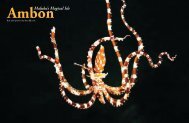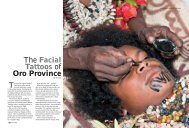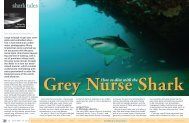Rapid Ecological Assessment - Indo-Pacific Images
Rapid Ecological Assessment - Indo-Pacific Images
Rapid Ecological Assessment - Indo-Pacific Images
- No tags were found...
You also want an ePaper? Increase the reach of your titles
YUMPU automatically turns print PDFs into web optimized ePapers that Google loves.
Chapter 2 - Socio-Economic Conditions in the Raja Ampat Islands<br />
The question of identifying the real indigenous people of Raja Ampat might not have been important in the<br />
past, but has become increasingly sensitive due to ownership disputes over resources, particularly fisheries<br />
and forestry. Silzer and Clouse (1991) charted the indigenous languages of Raja Ampat and their speakers. A<br />
summary of this information is listed in Table 4.<br />
Table 4. The indigenous languages of Raja Ampat and an estimation of the number of speakers.<br />
Language Dialect Location Speakers<br />
Matbat (Me, Biga) Misool and the surrounding smaller islands 550<br />
Salawati (Maya) Maya, Kawit, Banlol,<br />
Batanta Island<br />
Salawati and Batanta islands 1,600<br />
Kawe<br />
Legenyem<br />
Amber (Amberi,<br />
Waigeo, Waigiu)<br />
Kawe Island, western end of Waigeo and its<br />
neighboring smaller islands<br />
North-west of the main bay of Waigeo and on the<br />
southern coast of Waigeo<br />
North-center of Waigeo Island, and is scattered in<br />
various other parts of Waigeo<br />
300<br />
100*<br />
300<br />
* This figure did not originate from Silzer and Clouse (1991), but was estimated based on advice that the<br />
number of speakers of the Legenyem language was approximately one-third of the Kawe or Amber speakers.<br />
Based on the estimated number of indigenous Raja Ampat language speakers, it can be estimated further<br />
that, in 2002, the total number of indigenous people of Raja Ampat was about 3,250, or about 10% of the<br />
32,800 extrapolated from the 2000 population total at an annual growth rate of 1.2% (Table 5).<br />
2.6 Population Dynamics<br />
Population statistics for Raja Ampat are presented in Table 5. The data indicates that in 2000, the total<br />
population of Raja Ampat was approximately 32,000 people, or nearly 22% of the population of Sorong<br />
Regency. The indigenous component of the population is 10%, a figure that is likely to decrease with the<br />
onset of anticipated migration from other parts of <strong>Indo</strong>nesia with the opening of the nickel mine at Gag and<br />
other large-scale commercial ventures anticipated in the natural resources sector. This figure indicates that<br />
indigenous people in Raja Ampat are underrepresented in political decision-making, including the<br />
management of natural resources.<br />
Table 5. Raja Ampat population figures, 2000.<br />
Population Indicator<br />
Raja Ampat Districts of Sorong Regency<br />
Misool N. Waigeo S. Waigeo Samate Salawati*<br />
Total population 8,716 5,760 8,161 7,370 2,017<br />
Population density per km 2 3.90 5.52 3.64 9.49 n.a<br />
Sex ratio 102.43 97.75 101.25 96.82 n.a<br />
Household 2,415 1,649 2,484 2,934 n.a<br />
Village 19 15 29 11 n.a<br />
26





